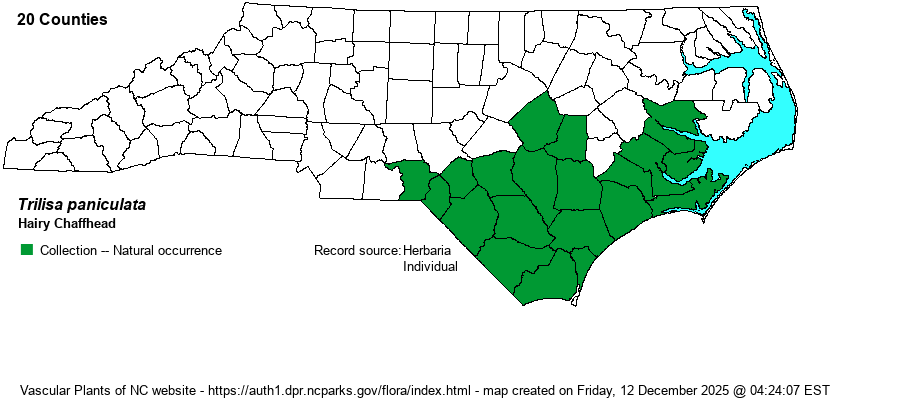| Section 6 » Family Asteraceae |
Show/Hide Synonym
| taxonName | relationship | relatedTaxonName | relatedTaxonRefText | relComments |
|---|
| Trilisa paniculata | = | Carphephorus paniculatus | | | | Trilisa paniculata | = | Carphephorus paniculatus | | | | Trilisa paniculata | = | Carphephorus paniculatus | Vascular Flora of the Southeastern States (Cronquist 1980, Isely 1990) | | | Trilisa paniculata | = | Carphephorus paniculatus | Wunderlin & Hansen Flora of Florida (3) | | | Trilisa paniculata | = | Carphephorus paniculatus | Cronquist (1980)=SE. | | | Trilisa paniculata | = | Carphephorus paniculatus | Cronquist (1980)=SE. | | |
|
|
| Trilisa paniculata | = | Carphephorus paniculatus | Flora of North America (1993b, 1997, 2000, 2002a, 2002b, 2003a, 2004b, 2005, 2006a, 2006b, 2006c, 2007a, 2009, 2010) | | | Trilisa paniculata | = | Carphephorus paniculatus | Godfrey and Wooten (1979, 1981) | | | Source: Weakley's Flora |
|
| Author | (J.F. Gmelin) Cassini | |
| Distribution | Southern Coastal Plain, scarce in the Sandhills. Ranges north to Johnston and Beaufort counties, with a more extensive range than T. odoratissima; neither ranges north into the northern Coastal Plain or into VA.
Coastal Plain, NC to southern FL and southern AL. | |
| Abundance | Fairly common to locally common in the southeastern counties, but mostly uncommon westward and inland to the Sandhills. Not as common in certain well managed pine savannas as is T. odoratissima but occurs in many more sites in the state. The State Rank probably can be moved to S3S4, if not straight S4. | |
| Habitat | Moist Longleaf Pine-Wiregrass savannas and flatwoods, blackwater streamhead ecotones, sandhill seeps. |
| Phenology | Flowering and fruiting August-October. | |
| Identification | Hairy Chaffhead grows 1-2 feet tall from a basal rosette of lance-shape leaves that have a whitish midrib. The stem is densely short-hairy and supports many small, ascending, elliptical leaves. The inflorescence is long and narrow, the pink to red-purple heads on short stalks. It recalls a miniature Vanilla-leaf, but has many points of difference -- that plant is quite smooth, is much taller, and the inflorescence is somewhat elm-shaped to flat-topped with many ascending branches. Carphephorus tomentosus is similar in its hairiness, but the inflorescence is sparingly flowered and has long horizontal branches -- imparting a somewhat flat-topped inflorescence as opposed to narrowly cylindrical. As with the other three species in the genera Trilisa and Carphephorus, when in bloom these four species impact a lovely rose-purple color to a savanna or flatwood in the fall season. | |
| Taxonomic Comments | Some references have moved the species into the other genus, named as Carphephorus paniculatus.
| |
| Other Common Name(s) | None | |
| State Rank | S3 [S3S4] | |
| Global Rank | G5 | |
| State Status | | |
| US Status | | |
| USACE-agcp | | |
| USACE-emp | | |

